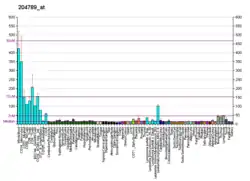FMNL1
Formin-like protein 1 is a protein that in humans is encoded by the FMNL1 gene.[3][4]
This gene encodes a formin-related protein. Formin-related proteins have been implicated in morphogenesis, cytokinesis, and cell polarity. An alternative splice variant has been described but its full length sequence has not been determined.[4]
References
- GRCh38: Ensembl release 89: ENSG00000184922 - Ensembl, May 2017
- "Human PubMed Reference:". National Center for Biotechnology Information, U.S. National Library of Medicine.
- Aronsson FC, Magnusson P, Andersson B, Karsten SL, Shibasaki Y, Lendon CL, Goate AM, Brookes AJ (November 1998). "The NIK protein kinase and C17orf1 genes: chromosomal mapping, gene structures and mutational screening in frontotemporal dementia and parkinsonism linked to chromosome 17". Hum Genet. 103 (3): 340–345. doi:10.1007/s004390050827. PMID 9799091. S2CID 11305597.
- "Entrez Gene: FMNL1 formin-like 1".
- Yayoshi-Yamamoto, S; Taniuchi I; Watanabe T (September 2000). "FRL, a novel formin-related protein, binds to Rac and regulates cell motility and survival of macrophages". Mol. Cell. Biol. UNITED STATES. 20 (18): 6872–6881. doi:10.1128/MCB.20.18.6872-6881.2000. ISSN 0270-7306. PMC 86228. PMID 10958683.
Further reading
- Kennerson ML, Nassif NT, Nicholson GA (1998). "Genomic structure and physical mapping of C17orf1: a gene associated with the proximal element of the CMT1A-REP binary repeat". Genomics. 53 (1): 110–112. doi:10.1006/geno.1998.5453. PMID 9787083.
- Yayoshi-Yamamoto S, Taniuchi I, Watanabe T (2000). "FRL, a novel formin-related protein, binds to Rac and regulates cell motility and survival of macrophages". Mol. Cell. Biol. 20 (18): 6872–6881. doi:10.1128/MCB.20.18.6872-6881.2000. PMC 86228. PMID 10958683.
- Strausberg RL, Feingold EA, Grouse LH, et al. (2003). "Generation and initial analysis of more than 15,000 full-length human and mouse cDNA sequences". Proc. Natl. Acad. Sci. U.S.A. 99 (26): 16899–16903. Bibcode:2002PNAS...9916899M. doi:10.1073/pnas.242603899. PMC 139241. PMID 12477932.
- Katoh M, Katoh M (2003). "Identification and characterization of human DAAM2 gene in silico". Int. J. Oncol. 22 (4): 915–20. doi:10.3892/ijo.22.4.915. PMID 12632087.
- Katoh M, Katoh M (2003). "Identification and characterization of human FMNL1, FMNL2 and FMNL3 genes in silico". Int. J. Oncol. 22 (5): 1161–8. doi:10.3892/ijo.22.5.1161. PMID 12684686.
- Favaro PM, de Souza Medina S, Traina F, et al. (2004). "Human leukocyte formin: a novel protein expressed in lymphoid malignancies and associated with Akt". Biochem. Biophys. Res. Commun. 311 (2): 365–371. doi:10.1016/j.bbrc.2003.10.012. PMID 14592423.
- Colland F, Jacq X, Trouplin V, et al. (2004). "Functional proteomics mapping of a human signaling pathway". Genome Res. 14 (7): 1324–1332. doi:10.1101/gr.2334104. PMC 442148. PMID 15231748.
- Gerhard DS, Wagner L, Feingold EA, et al. (2004). "The status, quality, and expansion of the NIH full-length cDNA project: the Mammalian Gene Collection (MGC)". Genome Res. 14 (10B): 2121–2127. doi:10.1101/gr.2596504. PMC 528928. PMID 15489334.
- Rual JF, Venkatesan K, Hao T, et al. (2005). "Towards a proteome-scale map of the human protein-protein interaction network". Nature. 437 (7062): 1173–1178. Bibcode:2005Natur.437.1173R. doi:10.1038/nature04209. PMID 16189514. S2CID 4427026.
- Olsen JV, Blagoev B, Gnad F, et al. (2006). "Global, in vivo, and site-specific phosphorylation dynamics in signaling networks". Cell. 127 (3): 635–648. doi:10.1016/j.cell.2006.09.026. PMID 17081983. S2CID 7827573.
This article is issued from Wikipedia. The text is licensed under Creative Commons - Attribution - Sharealike. Additional terms may apply for the media files.


